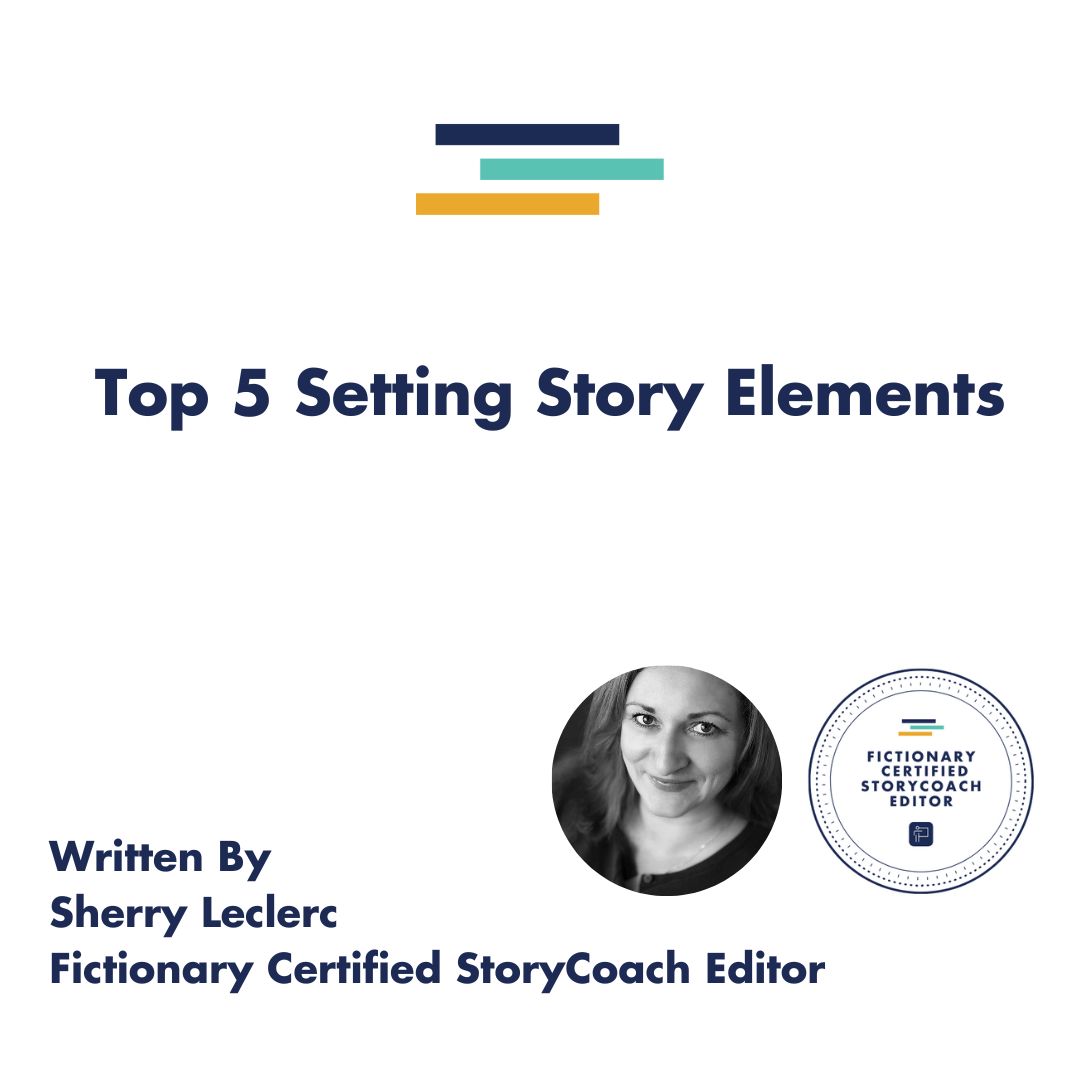What is the setting of a story?
The elements of a story in a novel are grouped into character, plot and setting. When we talk about the setting of a story and what it is, most people think of the location and time in which the action takes place. While this is a true—yet basic—definition of setting, a powerful setting can tell the reader so much more than the where and when of the story. A strong setting can help create the atmosphere of a scene or story. It can firmly place a story within a certain genre. It sets the mood and tone. It can mirror your characters’ emotions, or even serve as a contrast to highlight them even more. And yet, setting is often not used to its fullest potential.
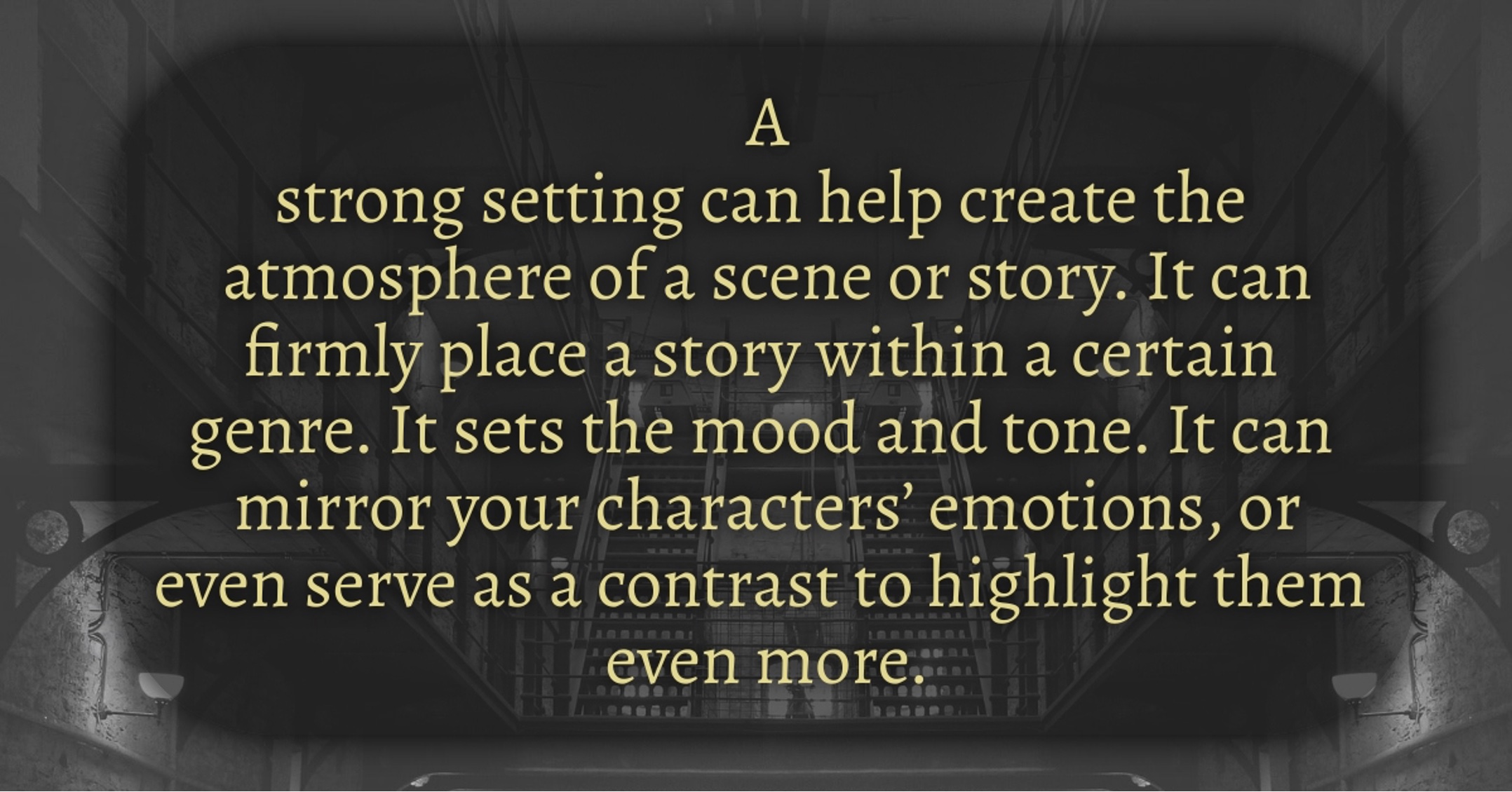
Setting is an essential part of what makes stories work or not, but it can be tricky to get just right. Creating your settings skillfully and artfully with the right amount of description can make your story or scene come to life on the page. However, if you don’t use enough description to set your scene, readers may be unable to immerse themselves in the story. Use too much and readers can get bored, putting the book down or skipping sections to get past the flood of details.
So, what can writers do to ensure they are using setting correctly and effectively? They can turn to the setting elements.
Five Setting Elements of a Story in a Novel Explained
You can see the elements of a setting listed differently depending on where you look. For example, in the article, What are the 4 Key Elements of Setting? By Bridget McNulty, they are listed as time, place, mood, and context. The article, Discover the Basics Elements of Setting in a Story by Courtney Carpenter lists many more elements. I would argue, though, that the elements these articles list can be shown through the correct use of the setting elements, as they are presented in Fictionary’s Storyteller software. Below are the five setting elements used in StoryTeller:
1. Location
2. Date / Time
3. Object(s)
4. The Five Senses (sights, smells, sounds, taste, touch)
5. Weather
Instead of giving the dictionary definitions of these terms, since they are all pretty self-explanatory, I will instead demonstrate most of them in action using the lead up to the climax scene and the climax scene itself in the psychological thriller Silence of the Lambs by Thomas Harris.
WARNING: SPOILERS AHEAD!
The Setting Elements at Work in The Silence of the Lambs by Thomas Harris
Location, date/time, and objects
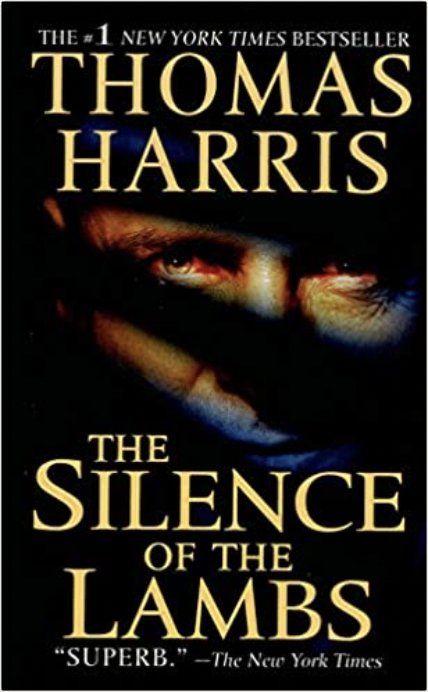 Location, date, and time all work closely together in the climax scene of The Silence of the Lambs and the scenes leading up to it, and even serve to link these scenes to earlier ones in the story. In these particular scenes, FBI trainee Clarisse Starling is in the small town of Belvedere Ohio (location).
Location, date, and time all work closely together in the climax scene of The Silence of the Lambs and the scenes leading up to it, and even serve to link these scenes to earlier ones in the story. In these particular scenes, FBI trainee Clarisse Starling is in the small town of Belvedere Ohio (location).
Clarisse is in Belvedere because she has managed to link an object from an earlier scene to an important piece of information about Jame Gumb’s, A.K.A. Buffalo Bill’s, first known victim. During one of her interviews with Hannibal Lector, Clarisse notices a drawing (object) that Lector put on the wall of his cell depicting “the Palazzo Vecchio and the Duomo, seen from the Belvedere” (p 18). Later, Starling learns that Buffalo Bill’s first victim was reported missing from her home town of Belvedere, Ohio.
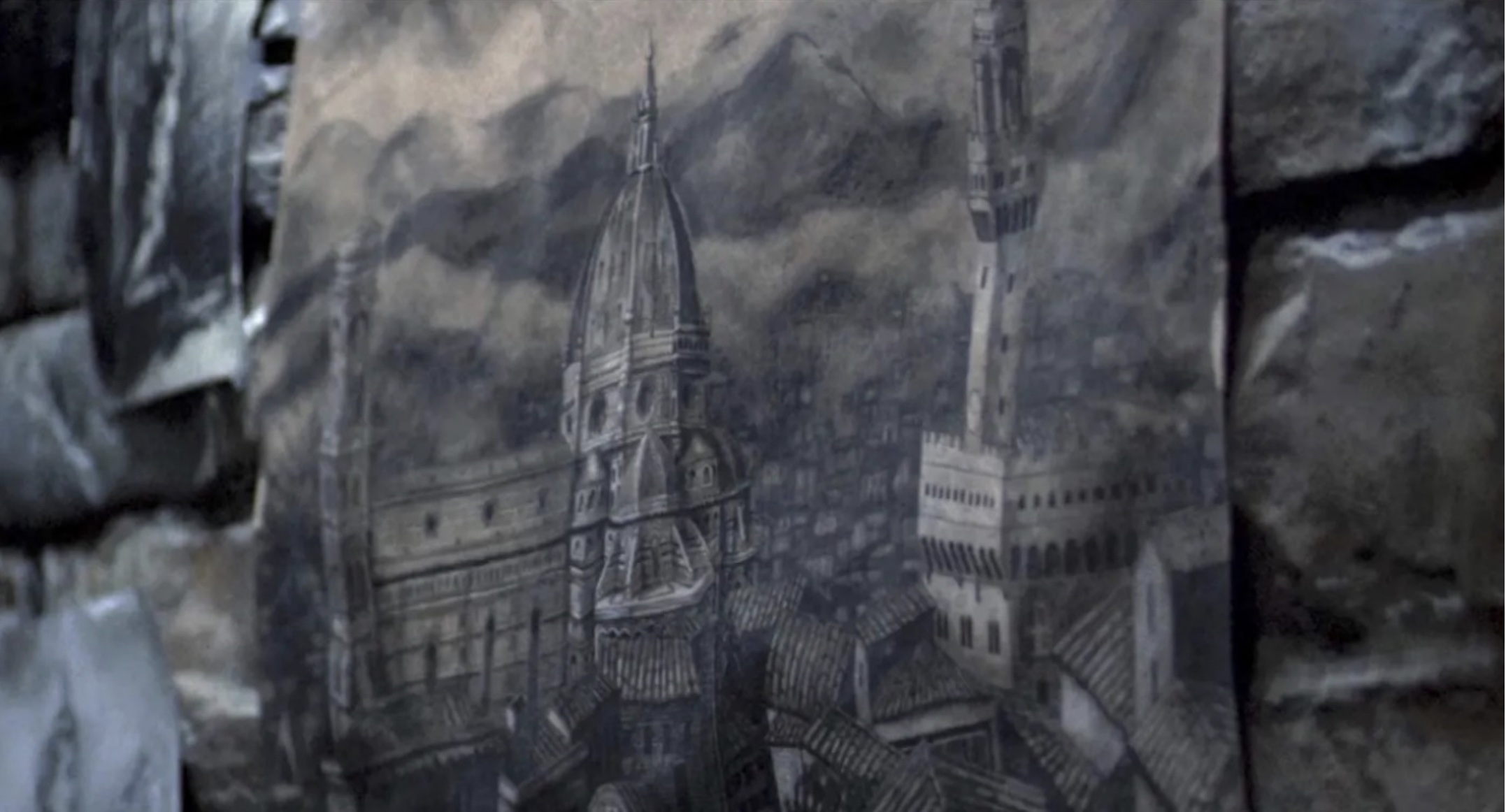
“The Duomo seen from the Belvedere,” from The Silence of the Lambs 1991 Film (image source: https://www.complex.com/pop-culture/silence-of-the-lambs-movie-facts-easter-eggs/)
The time element is also important in this story—not so much in the sense of dates or time of day, but in the sense of there being a “ticking clock,” so to speak. In the book, the FBI had already worked out by this point (with Lector’s help) that Buffalo Bill always kept his victims alive for a week to ten days (it was 3 days in the movie).
Even More Locations and Objects!
There are so many objects of importance in these scenes that it’s almost impossible to keep track of them all. Many of these objects also lead the heroine, and the reader, to other locations of importance.
For example, Starling goes to the home of the first victim, Frederica Bimmel, and sees (sight) a dress in her closet that has two diamond-shapes outlined in paper pinned to the lower back (objects). This one seemingly small finding helps Clarisse realize a number of things:
1. The diamond shapes cut out of the skin of the lower back of a previous victim were to make dressmaker’s darts
2. Frederica knew how to make clothing
3. This was Frederica’s link to Buffalo Bill (Clarisse and the FBI had already figured out, with the help of Hannibal Lector, that Buffalo Bill was making himself a girl suit).
Because of this, Starling was able to track down Frederica’s place of work (another scene location), which led to her discovering that she had worked for a seamstress named Mrs. Lippman. Though Mrs. Lippman had recently died, Clarisse got her address from Frederica’s friend and coworker, and Clarisse decides to go there next.
Although Clarisse (and perhaps the reader) doesn’t realize it right away, Mrs. Lippman’s house is one of the most important locations in the story. It is where Buffalo Bill is hiding out to make his girl suit, it is where he is keeping Catherine Martin, a senator’s daughter, prisoner.
It is another object that helps Starling realize that the man she is talking to is the killer himself, and that this is the location where the victim is being held. In an earlier scene, during the examination of one of the victims, Starling finds the cocoon of a Death’s-Head Hawkmoth. This insect is not native to America and its eggs would have had to be imported from overseas.
When Clarisse is talking to the man she believes to be a relative of Mrs. Lippman, a Death’s-Head Moth, which had been hidden on the man’s back until now, flies up from his back, at which point Clarisse realizes she is talking to Buffalo Bill himself. When the moth flies between them, Gumb realizes the jig is up, and he walks off into the basement.
The Use of the Senses (Story Elements) in the Basement Scene
For the sake of brevity, and for the sake of covering more of the setting elements, I’d like to focus on the use of the five senses in the basement scene.
At the beginning of this scene, Clarisse is taking everything in as she anxiously navigates the unfamiliar space. She is at a disadvantage in this location since this is her first time here, but it is a place that Buffalo Bill knows well and is comfortable with.
Description is used very effectively in this scene. At the beginning, we have Clarisse cataloging everything she sees, and the lights are described as “blinding” a number of times. Then, shortly after Clarisse finds the body:
Starling was seeing everything at once, the rope, the tub, the hand, the watch.
The tiny insect-crawl of the second-hand was the last thing she saw before the lights went out.
Her heart knocked hard enough to shake her chest and arms. Dizzy dark, need to touch something, the edge of the tub. The bathroom. Get out of the bathroom.
~The Silence of the Lambs, p. 345
Harris has her going from seeing “everything at once” to seeing absolutely nothing. But, immediately, her other senses kick in. We get descriptions of her navigating the space using her sense of touch—she feels along the walls while being mindful not to make too much noise (sound).
Not only does this increase the tension an incredible amount, but this particular moment is when we get the value shift in the scene. Clarisse’s situation has just moved from the negative of being in a basement she is not familiar with tracking a killer who knows the space very well, to the double-negative of still being in that space, but now without her sense of sight while the enemy uses night-vision googles.
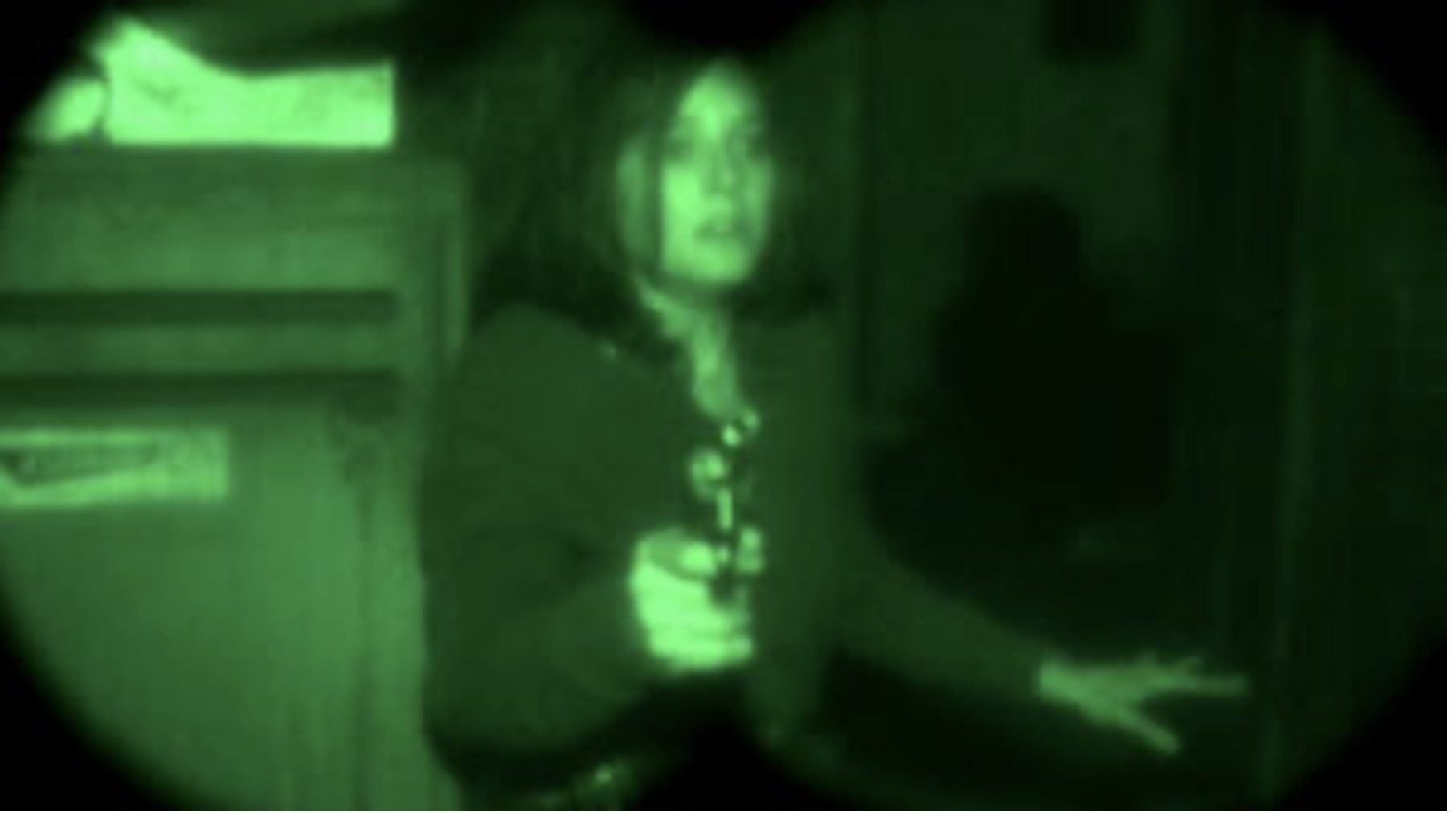
Image source: http://basementrejects.com/review/silence-of-the-lambs-1991/
We learn of that fact when the point of view suddenly shifts from Starling to Gumb. Starling’s attempt to make as little noise as possible is pointless, though she doesn’t know that at this point. While she can’t see anything, the killer is stalking her just fine. In such a situation, it would be difficult for any reader or viewer to envision how Starling is going to get out alive.
Except Starling is a very well trained, ambitious FBI trainee with exceptional hearing, which Harris was careful to set up early in the book and reinforce throughout. It is this training and that sense of hearing (sound) that saves her in the end. When Gumb, from mere feet behind her, pulls back the hammer on his revolver, Starling immediately recognizes the sound and turns and fires without hesitation. She hits Buffalo Bill with numerous shots to the chest, while he barely manages to graze her cheek despite his advantages.
Conclusion
Setting is everything in these scenes. In fact, all throughout The Silence of the Lambs, Thomas Harris artfully and skillfully uses the setting elements to engage his readers, build suspense, increase conflict and tension, and to bring his story to its highest points. And while the plot-driven stories we see in thrillers, action, and so on will rely more heavily on the setting elements than character-driven stories might, all stories can benefit from the artful use of description and the setting elements.
If you are a writer wanting to learn more about how to use setting more effectively in your own stories, check out the article Four Tips for Choosing a Story Setting, written by yours truly, on the Fictionary blog.
If you are an editor wanting to learn more about story editing, A.K.A. developmental editing for fiction, check out the article, Developmental Editing: Become the Best Fiction Author, by Pamela Hines.
Post Written by Sherry Leclerc
 Sherry Leclerc is a Fictionary Certified StoryCoach editor, Fictionary content creator, Writer’s Digest certified copy editor, and independent author. She is a member of Editor’s Canada, the Canadian Authors Association (CAA), and The Alliance of Independent Authors (ALLi).
Sherry Leclerc is a Fictionary Certified StoryCoach editor, Fictionary content creator, Writer’s Digest certified copy editor, and independent author. She is a member of Editor’s Canada, the Canadian Authors Association (CAA), and The Alliance of Independent Authors (ALLi).
Sherry holds a B.A. in English Language and Literature and a B.Ed. She is the sole proprietor of Ternias Publishing, through which she offers various editorial services. She also has a YouTube channel where she has a vlog about writing and editing, titled The Mythic Quill. You can find it on Youtube .
Sherry currently lives in Sydney, Nova Scotia, Canada. You can contact her at sherry@terniaspublishing.com or sherry@sherryleclerc.com.
![]()


